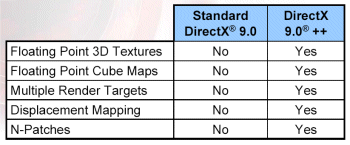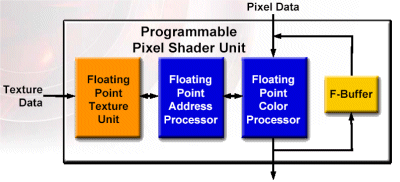With the Radeon 9800, 9600 and 9200 ATI has released a evolutionary set of new products that sure will give NVIDIA more incentive to try to catch up.
Introduction
It must be happy days over at ATI right now. Not only is the GeForce FX late and just barely edges ahead of the 9700, ATI is now ready to release their next batch of chips aiming squarely to make sure the FX never has the time to become King-of-the-hill.
A few weeks ago I was invited to a little pressmeating here in Stockholm with ATI where they presented their new line of chips: the Radeon 9800, the Radeon 9600 and the Radeon 9200.
DX9
Before we talk about the new chips lets talk about DirectX9. The new Radeon 9800 and the Radeon 9600 both not only support DirectX9 but have support for some extra features. ATI jokily called it DX9(++) support in response to NVIDIAs claim that the GeForce FX has DX9+ support.

The High-End
The Radeon 9800 is the new flagship from ATI. While not a revolution it is an evolution from the 9700. Lets take a look at some of the interesting fact about this chip:

Specifications:
- Supports DX9 and OpenGL2.0
- It is 0.15um and not 0.13 as some rumours have suggested
- The Radeon 9800 Pro is clocked at 380/680 MHz. Compare this to the 9700 pro (310/325 MHz). Right now I do not have info about the clockspeed of the regular Radeon 9800.
- 2.0 Vertex Shaders support vertex programs up to 65,280 instructions with flow control surface support
- 2.0 Pixel Shaders support up to 16 textures per rendering pass
- New F-buffer technology supports fragment shader programs of unlimited length
- 128-bit, 64-bit & 32-bit per pixel floating point color formats pixel shaders with video data
- The main difference compared to the 9700 is the support for Smartshader 2.1, Smoothvision 2.1 as well as HyperZ III+.
Smartshader 2.1
ATI has upped the ante in the shader-race with NVIDIA. The Radeon 9800 supports Smartshader 2.1. This means:
Compared to the GeForce FX the 9800 has some advantages:
The new F-buffer technology makes it possible to execute pixel shader programs with an unlimited number of instructions, without the costly performance overhead associated with multi-passing the rendering pipeline. As Im no tech-wizz I will let ATI tell you more about it:
The F-buffer, short for Fragment-stream FIFO buffer, is the first hardware implementation of an idea proposed in a paper by graphics researchers William Mark and Kekoa Proudfoot at Stanford University (http://graphics.stanford.edu/projects/shading/pubs/hwws2001-fbuffer/). It handles complex effects by passing only the pixels that require multi-passing through the pixel shader engine multiple times, while doing all the other steps in the rendering pipeline just once per pixel. Multi-pass pixels are stored in the F-buffer between passes, rather than writing them out to the frame buffer, so transparent pixels can have foreground and background colours stored separately. This technique saves rendering time, reduces memory bandwidth requirements, and gracefully handles transparency
While it might be hard to understand what the Smartshader 2.1 support really means I guess it can be summarized with More complex effects, better performance.
Smoothvision 2
Just like the Radeon 9700, the Radeon 9800 supports up to 6x AA and 16x anisotropic filtering. It also supports AA Gamma Correction. In the Radeon 9800 ATI has improved performance of both AA and anisotropic filtering.
Hyper Z III+
Not much to say about this. They have improved the memory bandwidth efficiency as well as optimized the Z-cache to enhance the performance of shadow volumes by better optimizing it to work with stencil buffers. The last point might not be so important right now since not many games use stencil buffers for shadows but games like Doom3 are expected to start using this more heavily.
Conclusion Radeon 9800
As I said in the beginning the Radeon 9800 isnt a revolution but an evolution of the Radeon 9700. That isnt necessarily a bad thing but it means that anyone with a Radeon 9700 pro should take a close look at the benchmarks to see if it is worth upgrading. To help you make an educated opinion about the performance you can read my first review of the Radeon 9800 Pro which will be out in an hour or so. The first benchmakrs show that the Radeon 9800 does draw ahead of the radeon 9700 with 10.30% depending on the resolution and what AA and anisotropic filtering that has been used. Stay tuned for more!.
The Radeon 9800 Pro will be available in March and the RSP will be $399. Add the usual VAT of your country to get an approximation of the price.
Later in Q2 the regular Radeon 9800 will be out (RSP $349) as well as a 256 MB Radeon 9800 pro which will sport 256 MB DDR2 memory (RSP $499). When question about the need for 256 MB ATI had no problem admitting that this was overkill right now but they pointed to the fact that 128 MB was considered overkill a while ago when the first 128 MB boards came out. Doom 3 will definitely take advantage of the extra memory.
Ok, that was the highend. Let’s move on to the mainstream.
The Radeon 9600

The Radeon 9600, just like the Radeon 9800, now supports both DX9(++) as well as OpenGL 2.0.
The main ‘feature’ of the Radeon 9600 of course is the fact that this is ATI’s first VPU that is 0.13um. When questioned why they didn’t use the 0.13 process for the Radeon 9800 they said that they choose to do it on the Radeon 9600 first since
Moving to a .13 process means the ability to pack more stuff into a smaller die as well as make the chipset use less power. ATI talked about the possibility to get a fan-less version of the Radeon 9600 which uses no fan. For anyone who wants to build a quiet PC this sounds like a great product. Not that the Radeon 9800 Pro that is rolling in my machine is noisy …
Here are the specs of the Radeon 9600:
- DX9 and OpenGL2 support
- The Radeon 9600 will be clocked at 325/400 and the Radeon 9600 pro at 400/600
- Quadpixel pipeline (16 textures/pass, 128 bit floating point precision)
- Dual Vertex Pipeline
- Hyper Z III Performance optimizations
- Smartshader 2.1
- Smoothvision 2.1
Both the Radeon 9600 and the Radeon 9600 pro will be out in April. RSP for the 9600 will be around $149-169 (plus local VAT) and $169-199 for the Radeon 9600 Pro
The Radeon 9200

Both the Radeon 9200 and the Radeon 9200 Pro will be available in April and the 9200 will retail for around $79-$129 (plus local VAT) and the 9200 Pro will retail for $129-$149.
Summary
ATI themselves didn’t call this their next generation of cards. These are just fine-tunes of the existing products. As these products are being released you will see the 9700, the 9500 and the 9000 disappear from the shelves.
These lineup proves that ATI isn’t sitting still waiting for NVIDIA to catch up. While NVIDIA still is struggling to get their first DX9 products out ATI is already on the next set of DX9 cards. Now what will be insteresting to see is of course NVIDIA’s response. Will they let the Radeon 9800 sit alone in the top? or do they have something up their sleave? I guess only time will tell.
 Bjorn3D.com Bjorn3d.com – Satisfying Your Daily Tech Cravings Since 1996
Bjorn3D.com Bjorn3d.com – Satisfying Your Daily Tech Cravings Since 1996




